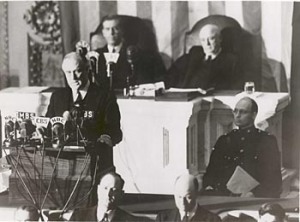Moments before 8 a.m. on December 7, 1941, the United States was ‘suddenly and deliberately attacked.’ Hundreds of Japanese fighter planes and bombers launched a surprise assault on Pearl Harbor in Hawaii. The swift, devastating volley on the U.S. naval base killed 2,403 Americans. With President Franklin D. Roosevelt’s famous “a date which will live in infamy” proclamation, America had finally joined WWII.
 That momentous week of loss and defiance took place seventy-five years ago. After Pearl Harbor, the U.S. fought Imperial Japanese forces for a superior hold in Pacific waters. On the list of the 10 greatest battles of that front, you will find Midway, Coral Sea, and the Philippine Sea. GPO makes available a U.S. Naval War College study, Major-Fleet Versus-Fleet Operations in the Pacific War, 1941-1945, that takes a look at those three major naval operations.
That momentous week of loss and defiance took place seventy-five years ago. After Pearl Harbor, the U.S. fought Imperial Japanese forces for a superior hold in Pacific waters. On the list of the 10 greatest battles of that front, you will find Midway, Coral Sea, and the Philippine Sea. GPO makes available a U.S. Naval War College study, Major-Fleet Versus-Fleet Operations in the Pacific War, 1941-1945, that takes a look at those three major naval operations.
Japanese planning in the Pacific War, according to author and naval historian Dr. Milan Vego, was unnecessarily complicated and focused too closely on offensive maneuvers. Nonetheless, Japan was hell-bent on defeating the U.S. Pacific fleet.
American military intelligence, and eventually the entire fleet, prevailed. The book’s primary-source archival material points to the timely concentration of U.S. forces at the appropriate place and at the appropriate time. The U.S. dominated the resultant Coral Sea, Midway/Aleutians, and the Philippine Sea battles—victories that presented a big sea change in the Pacific theater.
The author provides a detailed, well-supported sketch of three major battle areas that decisively shaped WWII. Maps, strategic context, and action analysis provide an authoritative, insightful resource for naval professionals. Major-Fleet Versus-Fleet Operations in the Pacific War identifies universal, tactical lessons of interest for today’s U.S. Navy and, of course, military history buffs.
HOW DO I OBTAIN THIS RESOURCE?
Shop Online Anytime: You can buy eBooks or print publications —with FREE Standard Shipping worldwide— from the U.S. Government Online Bookstore at http://bookstore.gpo.gov.
- Click here to purchase Major Fleet-Versus-Fleet Operations in the Pacific War, 1941-1945
- Click here to purchase Talking About Naval History: A Collection of Essays
- Click here to purchase Arming the Fleet: 1943-2011, Providing Our Warfighters the Decisive Advantage
- Click here to browse our World War II collection
- Click here to browse our Wars & Conflicts collection
Shop our Retail Store: Buy a copy of any print editions from this collection at GPO’s retail bookstore at 710 North Capitol Street NW, Washington, DC 20401, open Monday–Friday, 9 a.m. to 4 p.m., except Federal holidays, Call (202) 512-0132 for information or to arrange in-store pick-up.
Order by Phone: Call our Customer Contact Center Monday through Friday, 8 am to 5:30 pm Eastern (except US Federal holidays). From US and Canada, call toll-free 1.866.512.1800. DC or International customers call +1.202.512.1800.
Visit a Federal depository library: Search for U.S. Government publications in a nearby Federal depository library. You can find the records for most titles in GPO’s Catalog of U.S. Government Publications.
About the author: Blogger contributor Chelsea Milko is a Public Relations Specialist in GPO’s Public Relations Office.





 Posted by Trudy Hawkins
Posted by Trudy Hawkins 




